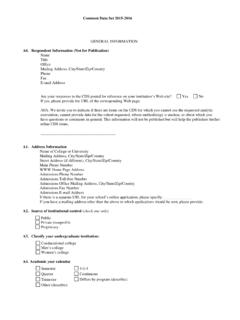Transcription of Ten Common Mistakes Setting Up a Software QA …
1 Ten Common Mistakes Companies Make Setting Up and Managing Software Quality Assurance Departments By Peter B. Wilson, Executive Vice President Mosaic, Inc. Mosaic, Inc. 205 N. Michigan Ave. Suite 2211. Chicago, IL 60601. (312) 819-2220. Mosaic, Inc. All rights reserved 2004-2009. In the late 70s and early 80's, when the Japanese were teaching the world about manufacturing quality, I was establishing a Software quality program and managing a Software Quality Assurance (QA) department. My department was very successful. We significantly increased the profitability of our projects, improved customer satisfaction, and gave the company a significant competitive advantage.
2 With hindsight and experience, I now understand the key factors that made our QA department so effective. Since that time, I have seen dozens of Software Quality Assurance departments come and go. Some were successful. Most, however, had limited success and were eventually abandoned. The purpose of this article is to describe Common Mistakes companies make when Setting up and managing a Quality Assurance department. Let me add up front that by QA, I do not mean testing . Rather, I am describing a function with the responsibility to ensure that Software will meet its intended requirements functional, date, budget, etc.
3 testing is important, but it is different. testing can prove that a system does not meet its requirements. It cannot ensure that a system will meet its requirements. testing is quality control; it is not quality assurance. If you do not have a QA department, you are probably trying to improve Software quality by some other means advancing to the next CMMI (Capability Maturity Model . Integration) level, with an SEPG ( Software Engineering Process Group), a PMO (Project Management Office), IT Governance, or a similar effort. As you read this article, I think you will find that most, if not all, of the same issues are relevant to these efforts.
4 Mistake 1: Not properly defining objectives. The primary objective of a QA department should be to ensure successful projects. While this may seem obvious, I have rarely seen this objective stated or followed. Most QA departments are established without a well-defined objective or with an objective something like: Improving quality Achieving CMM level X. Implementing a new methodology Process improvement These are good secondary objectives, but they are not the same as ensuring successful projects. There are many situations where overemphasis on a single laudable goal is counterproductive.
5 Focus too much on any one goal ( , date, budget, user requirements, etc.) and you will likely meet that goal at the expense of the success of the project. For example, IBM had a better operating system with OS/2, but lost the marketing battle to Microsoft's Windows because IBM was too late getting to market. On the other hand, many Software companies have caused themselves significant problems by rushing new product releases to market before they were ready. 1. Mosaic, Inc. All rights reserved 2004-2009. What is a successful project? Defining success is not always easy.
6 It can also be very situational. When I was managing a QA department, my company was a medium-sized consulting firm that would take project responsibility for developing systems. My firm's definition of a successful project meant that the project must meet two criteria: The client must be satisfied: The client would pay their bills, would allow us to use them as a reference and, budgets permitting, there would be repeat business. The business would be profitable: This objective could easily conflict with the first. This objective meant we could not keep the client happy by doing work for free.
7 Ensuring an organization's success can also conflict with ensuring an individual project's success. This is very Common and usually occurs when there are limited resources that must be allocated staff, budget, user time, senior management time, QA time, etc. There are several strategies my firm used to address this problem: We would avoid projects where success would be in doubt because adequate resources could not be provided. (This can be very hard to do in practice.). We would allocate resources where they would have the most impact. The QA department, for example, would rank projects by risk.
8 QA resources would be allocated first to high-risk projects, then to lower risk projects. QA. activity on low-risk projects would be deferred if necessary. We would communicate the risks and issues to Senior Management. When appropriate, the issues would be resolved and key decisions would be made by senior management. The tradeoff between cost, target dates, quality, and user satisfaction can differ significantly from organization to organization and even from project to project. Success may be very target date driven on one project ( , tax Software ), quality driven on another project ( , life critical Software ), cost ( , most projects), or user satisfaction.
9 Success is usually some combination of these factors and other factors. Achieving success may require different strategies depending on a number of factors including: the size and experience of the project team, the nature of the requirements, the technology, user involvement, etc. In some cases success may mean minimizing financial loss , killing a project before too much money has been spent. 2. Mosaic, Inc. All rights reserved 2004. Mistake 2: Not properly defining a Quality Assurance department's responsibilities and staffing to meet these responsibilities.
10 Ensuring successful projects requires a QA department to work with project managers to ensure that: A process is defined that if followed will result in the success of the project and The process is followed. This view of a QA department's responsibilities goes beyond defining the responsibilities of the QA group to be just defining process and conducting reviews. Ensuring project success requires QA staff to work more closely (and perhaps earlier in the project) with project management than do most QA departments. Ensuring success means that QA. must take responsibility (with the project manager) for the success of the project.






